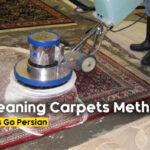
Cleaning Carpets with 5 Different Methods
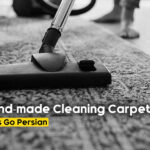
Handwoven Carpet Washing Guide
The Rise of Modern Looms: Transforming Iran’s Carpet Industry
The history of the Iranian machine-made carpet industry, compared to the longstanding tradition of the country’s handwoven carpet industry, indicates that this industry is relatively young, only 50 years old and lacking a long history in Iran. The first whispers of machine-made carpet production in Iran emerged in 1960 with the establishment of the “Shahpasand Carpet Weaving Company” by a wealthy family in Kashan. This initiative became one of the most controversial debates in the history of Iran’s industry. At that time, the prevailing opinion among experts was firmly against industrializing carpet production in Iran, believing it would lead to nothing but the destruction of the art and industry of handwoven carpets in the country.
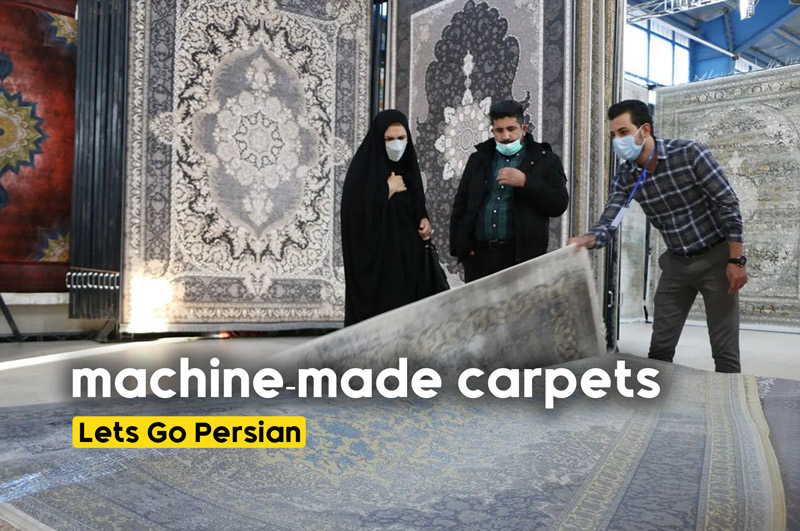
The employment of a significant workforce, considerable export income, and the global reputation of Iran’s handwoven carpets were among the factors that led to resistance against investing in the Iranian machine-made carpet industry. This difference of opinion escalated to the point where it became a matter of discussion between the ministers of economy and labor and the prime minister at the time. Even the royal court became involved in an attempt to resolve the disagreements. As a result of heavy domestic pressures and administrative disputes, a legal framework was approved during specific periods, under which, if a machine-made carpet factory was discovered, all related machinery and equipment would be confiscated and rendered useless, and the violator would be subject to cash fines or imprisonment.
According to this law, penalties were also considered for buyers, purchasers, and distributors. Therefore, the most significant reason for the lack of machine-made carpet production in Iran was the prohibition of the industrial output of this commodity due to the support for handwoven carpets. However, after several years, conditions took a different turn.
In 1972, the Kashan Velvet and Silk Company began producing machine-made carpets by importing six carpet weaving machines. These carpets were made from acrylic yarn woven in a cotton weaving system within the company.
Also, the same year, the Beshahr Industrial Group signed a contract to produce 10 million square meters of machine-made carpets with Belgium. It obtained a license to make this product in Iran. In late 1973, the Kashan Industries Company started the mass production of machine-made carpets under the trade name “Ravand.”
Regarding knot count, these carpets were similar to the 28-raj handwoven carpets of Kashan, which were mainly woven in Kashan at that time and considered medium-density carpets. Cotton warp threads were used in weaving the first samples of machine-made carpets in Iran. The presence of woolen weft threads and the cotton warp threads made the machine-made carpets bear a striking resemblance to handwoven carpets.
In 1975, three more machine-made carpet production units were launched. The first, “Pars Carpet,” started operating in the industrial city of Qazvin. The second, called “Shahr Baft” (renamed to “Gilan Carpet” after the revolution), almost simultaneously started operating in the city of Rasht. The third, “Shahpasand Carpet,” finally established its factory in Kashan. All three production units imported Mako two-ply weaving machines from East Germany and produced Texima machine-made carpets. During this period, the Kashan Velvet and Silk Company also imported 12 pileless (Rapier) weaving machines to the country.
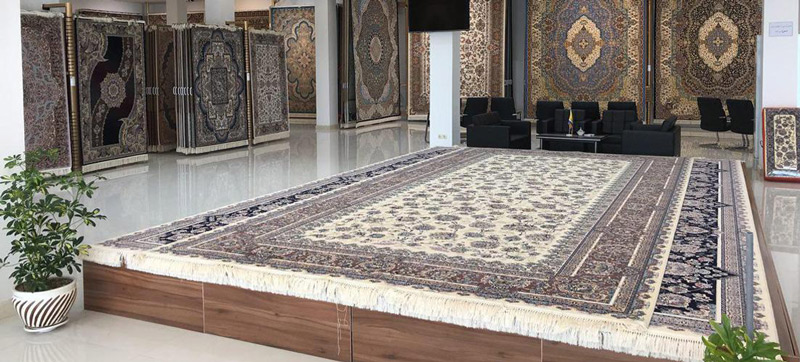
Until before the Islamic Revolution in Iran, a total of 15 machine-made carpet production units were established, including “Kashan Carpet Industries (Ravand Carpet), Pars Carpet, Gilan Carpet, Shahpasand Carpet, Molen Rouge Carpet, Mazandaran Carpet, Alborz Carpet, Isfahan Weaving Carpet, Shiraz Carpet, Bastan Yazd Carpet, Kashan Velvet and Silk, Akbatan Carpet, Mashhad Carpet, and Isfahan Ray and Florimat Weaving.” After the revolution, eight units of this collection became part of national industries, and seven private teams remained.
Due to the affordability of machine-made carpet prices and the domestic enthusiasm for purchasing this product in the first ten years of this industry’s activity in Iran, all productions were sold domestically, and there was no export in this area. The domestic market demand was so high that at times, such as in the late 1970s and early 1980s, pre-sale contracts for machine-made carpets were handed over to the general public, especially those trying to furnish their homes and who could not afford handwoven rugs.
After the revolution, the Ministry of Industries, under the assumption that it was supporting handwoven carpets, did not issue permits for the establishment of new machine-made carpet production units, and only two teams, namely “Nakhshin Kurdistan Carpet” and “Delijan Carpet,” succeeded in obtaining licenses and starting production.
After the war’s end, in the late 1980s, the Ministry of Industries, with an apparent turn, pursued a policy of relatively easy issuance of licenses for machine-made carpet production units. This marked the beginning of the rapid growth of small machine-made carpet production companies in cities such as Kashan, Isfahan, Mashhad, Yazd, Delijan, etc. The ease of obtaining a founding license, economic conditions after the war, a high population growth rate in the country, and consequently the existence of a young and active workforce, the low technology of the production line machinery and the possibility of indigenous production, and ultimately, a highly favorable market, all contributed to the accelerated growth of these fledgling machine-made carpet factories in the 1990s. In the second half of this decade, unofficial and then official exports to neighboring countries such as Afghanistan, Pakistan, and Iraq began. Most exported carpets to these three countries were inexpensive machine-made carpets suitable for their domestic markets, such as 350-shaft polypropylene carpets or 440-shaft acrylic and polypropylene blend carpets.
With the number of machine-made carpet factories in Kashan, this region has become a hub for production in Iran. These factories gradually established themselves in three industrial zones: Rawand, Amirkabir, and Soleyman Sabahi. Later, additional industrial zones such as Halal, Fath Al-Mobin, and Ansar were added to this collection. In addition to the companies located in these industrial zones, some machine-made carpet factories were established around Kashan and outside the boundaries of the industrial zones. The number of factories in this region reached approximately 900 production units. At certain times, the number of working carpet-weaving machines reached 1,500, owing to the entry of new machinery and technological advancements. However, many small factories lost their competitive edge with the latest machinery and technology upgrades and phased out of the production cycle.
During these years, the number of machine-made carpet factories in other cities was also increasing, but at a much slower rate compared to the Kashan region. The significant difference in establishing machine-made carpet factories in Kashan compared to other provinces lay in the volume of investment, the number of carpet-weaving machines in each factory, the technology of the machinery, and, consequently, their production capacity.
In the Kashan region, most factories were established on a tiny scale, with one or two Maku carpet-weaving machines, while in cities such as Mashhad, Yazd, and Isfahan, the production capacity of each factory was equivalent to the production of several factories in Kashan. Examples of large companies located throughout the country, excluding the Kashan region, include the “Mashhad Carpet Group” founded in 1979 in Khorasan Razavi province (brands such as Mashhad Carpet, Negineh Carpet, Zomorod Carpet, and related weaving), the “Star of Kavir Yazd Group” based in Yazd province, founded in 1981 (brands such as Star of Kavir Yazd, Memory of Kavir Carpet, etc.), “Savineh Carpet” in Tehran province, established in 1999 (affiliated companies including Razi Weaving Company, Fartab Industrial and Manufacturing Company, and Savineh Tab Company), “Soleiman Carpet Company” located in Isfahan province, “Golden Nation Star Carpet Company” established in 1991 in Isfahan province, “Sheikh Safi Carpet Company” based in Isfahan province, established in 1994, and “Tehran Weaving Company” established in Natanz County, Isfahan province, in 1982 (acrylic yarn weaving unit) and 1991 (carpet-weaving unit).
In general, Isfahan province, with about 75% of the country’s machine-made carpet production capacity, held the first rank, followed by areas such as Yazd, Khorasan Razavi, Markazi, Tehran, West Azerbaijan, Mazandaran, and others. Over time, as the technology of carpet-making machines improved and production became more specialized, the number of factories in other provinces decreased. In contrast, with the development of the necessary infrastructure for this industry, increased capital investment, and the entry of the world’s most modern carpet-weaving and dyeing machines into the Kashan region, the carpet industry in this area flourished and has become one of the world’s important centers for machine-made carpet production.
From a technological perspective, the carpet-weaving machines installed in the numerous machine-made carpet factories in the 1990s were either domestically produced Maku machines or old foreign machines in Iran. Due to the strong demand for carpet-weaving devices, machine manufacturing began domestically in the late 1980s. In the late 1980s, some engineers and technicians from the Kashan Industries Company (Rawand Carpet) started manufacturing parts and assembling carpet-weaving machines by copying the Vandewiele machines available in those factories. In this way, the peak of machine manufacturing in the machine-made carpet industry occurred in the 1990s. Hundreds of domestically produced Maku carpet-weaving machines, primarily replicas of foreign models, were made, installed, and put into operation by several domestic machine manufacturing companies.
The low technological level of these machines and the mechanical nature of most of their parts and mechanisms made it easy to copy the parts and assemble the devices. For this reason, numerous domestic machine manufacturing companies (especially in Kashan) emerged, leading to intense competition. However, financial problems, a lack of teamwork culture, a downturn in the market for carpet-weaving machines, and a recession in the machine-made carpet market in the late 1990s led to almost all domestic machine manufacturing companies closing down, except for two companies “Sanie Isfahan” and “Rad Kashan.” In the following years, with the entry of second-hand foreign carpet-weaving machines, heralding the emergence of a new generation of upgraded carpet-weaving devices, and the failure to upgrade the technology of domestically produced machines, all domestic machine manufacturing companies ceased operations. In other words, at the beginning of the 21st century, the construction of carpet-weaving machines in the country was practically halted.
Especially in Isfahan province, with about 75% of the country’s machine-made carpet production capacity, held the first rank, followed by areas such as Yazd, Khorasan Razavi, Markazi, Tehran, West Azerbaijan, Mazandaran, and others. Over time, as the technology of carpet-making machines improved and production became more specialized, the number of factories in other provinces decreased. With the development of the necessary infrastructure for this industry, increased capital investment, and the entry of the world’s most modern carpet-weaving and dyeing machines into the Kashan region, the carpet industry in this area has flourished. It has become one of the world’s important centers for machine-made carpet production.
From a technological perspective, the carpet-weaving machines installed in the numerous machine-made carpet factories in the 1990s were either domestically produced Maku machines or old foreign machines in Iran. Due to the strong demand for carpet-weaving devices, machine manufacturing began domestically in the late 1980s. In the late 1980s, some engineers and technicians from the Kashan Industries Company (Rawand Carpet) started manufacturing parts and assembling carpet-weaving machines by copying the Vandewiele machines available in those factories. In this way, the peak of machine manufacturing in the machine-made carpet industry occurred in the 1990s. Hundreds of domestically produced Maku carpet-weaving machines, primarily replicas of foreign models, were made, installed, and put into operation by several domestic machine manufacturing companies.
The low technological level of these machines and the mechanical nature of most of their parts and mechanisms made it easy to copy the parts and assemble the devices. For this reason, numerous domestic machine manufacturing companies (especially in Kashan) emerged, leading to intense competition. However, financial problems, a lack of teamwork culture, a downturn in the market for carpet-weaving machines, and a recession in the machine-made carpet market in the late 1990s led to almost all domestic machine manufacturing companies closing down, except for two companies “Sanie Isfahan” and “Rad Kashan.” In the following years, with the entry of second-hand foreign carpet-weaving machines, heralding the emergence of a new generation of upgraded carpet-weaving devices, and the failure to upgrade the technology of domestically produced machines, all domestic machine manufacturing companies ceased operations. In other words, at the beginning of the 21st century, the construction of carpet-weaving machines in the country was practically halted.
In the early 2000s, with the entry of second-hand Rapier carpet-weaving machines from foreign countries (especially Turkey) into Iran, the first wave of modernization of carpet-weaving machines and upgrading their technology began. These machines, with two significant differences from the working Maku machines, included eliminating the Maku system in the carpet’s weft insertion mechanism and the electronic Jacquard system. In addition, imported carpet-weaving machines had other advantages, such as higher production speed and efficiency, significantly reduced noise and machine wear, higher weaving quality, and more. As a result, many sizeable machine-made carpet production factories quickly upgraded themselves.
Shortly after, some larger companies significantly increased their technological production distance from competitors by purchasing and launching modern carpet-weaving machinery. With the initiation of quickly yielding bank facilities and other aids from government and private bank resources, the rapid technological advancement of machinery took place. This can be referred to as the second wave of reconstruction in the machine-made carpet industry.
The substantial investment in various sectors of the machine-made carpet industry and related industries (dyeing, yarn, dyeing, weaving, shearing, electronic services, pattern design, etc.), especially in the Kashan region as the hub of Iran’s machine-made carpet industry, brought about a remarkable transformation in the quality and diversity of the products produced and the export of Iranian machine-made carpets.
These transformations occurred at such an accelerated pace that the technological gap between Kashan’s machine-made carpet factories and those in other provinces reversed. With the introduction of 1500-shaft carpet-weaving machines, the highest level of technology in the world, these machines operate in this region.
With the determined efforts of the machine-made carpet industry owners, especially during economic sanctions, Iranian machine-made carpet exports reached around $350 million in 2014 and $550 million in 2018. This signals the possibility of achieving the ultimate goal of Iran’s machine-made carpet industry, namely, one billion dollars in exports by 2025.
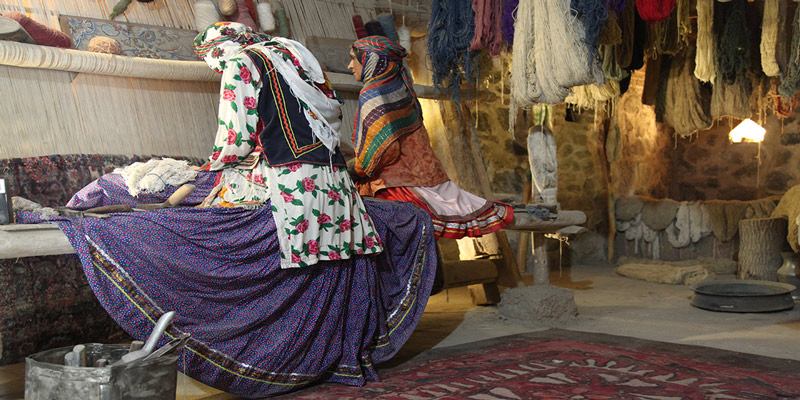
Despite all these advancements, it should not be ignored that machine-made carpets are still considered in Iran as something non-authentic and, of course, inexpensive. If someone can afford a handmade carpet, they would never turn to machine-made carpets. In the meantime, it should be noted that the entry of carpet-weaving machines ultimately impacted the handwoven carpet industry in Iran. If there were severe policies to support carpet weaving workshops, the capital market, the power of physique, and maneuvering in the Iranian carpet market would not have been lost.



















